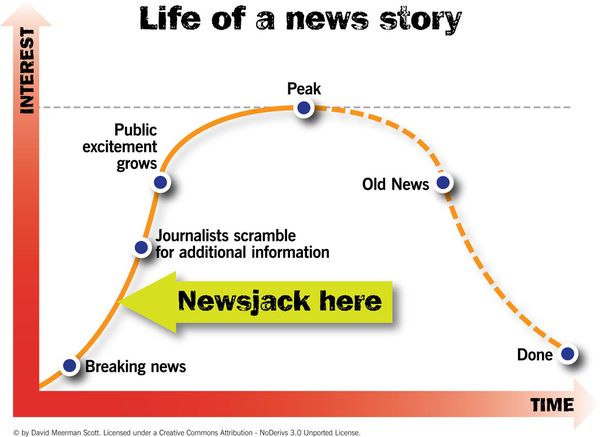The birth of 24-hour news stations has seen our thirst for news reach unparalleled heights. Whatever your opinions on this as a consumer there is no arguing that the more ‘news’ there is the more opportunities we marketeers have to newsjack.
What is newsjacking?
Newsjacking, if done effectively, will help you generate brilliant content ideas. Simply put, it involves latching your brands ideas or concepts onto breaking news and attempting to benefit from the original story’s media coverage.
Though newsjacking doesn’t have strict guidelines it can be tricky spotting an opportunity or knowing what stories to piggyback. So here are six tips to help:
Be aware
Opportunities to newsjack can happen at the most unlikely of times from the most unlikely of sources, so the key is to always be on the ball. Keeping a vigilant eye on the news, listening to the radio or setting up Google alerts can be the easiest way to ensure you don’t miss an opportunity. Likewise social media monitoring.
Spotting a newsworthy story just as it’s emerging is a huge advantage and already puts you ahead of the crowd. A good example of this is when Kate Winslet rescued Richard Bransons elderly mother from his burning mansion in the British Virgin Islands. London Fire Brigade decided to write a blog post inviting Kate to come and train with them. Once journalists heard about the offer it resulted in tons of free publicity, high site traffic and plenty of inbound links!

Be precise
Target the stories you wish to newsjack and stick with it. When starting out maybe begin by monitoring certain areas of the news and the audience associated with the topics. Flesh out the key influencers and experts, so if a quick quote is needed you’ll know who to go to. Social networking sites can be hugely helpful when researching your audience; monitoring trends and hash-tags can help spot stories of interest and how they travel on their viral journey.
Be fast
Newsjacking generally only works if you’re the first to do it. Once you’ve highlighted a link between the story and the brand, act fast! Breaking news is short lived so getting the timing right is essential. Jumping on the bandwagon late, will be of little benefit, conversations will have moved on to fresher topics and result in your story receiving little or no attention.
Be thoughtful
Bad news often overshadows the morning headlines and any brands wanting to attach themselves to such stories should err on the side of caution. Be sensitive and think about the people this story is affecting, if your brand can offer an appropriate solution then by all means go ahead. There are brands however, that haven’t always got it right. In October last year whilst Hurricane Sandy wreaked havoc along the east coast, American Apparel decided to email their customers with a map highlighting the regions the Hurricane was affecting. Along with the infographic American Apparel encouraged customers in the affected areas to shop in the Superstorm Sandy Sale. Quite rightly the brand received an immediate backlash in the news and online.
Don’t imitate
Copying what another brand has said or done will look unimaginative and completely defeat the point of newsjacking. Make sure you put your own spin on the concept; this will ensure that your brand stands out from the reams of content that will most likely follow.
Plan
Although newsjacking is generally a reactive practice there are times when its possible to plan ahead. Events that are in the diary well in advance provide great opportunities to get strategic with your newsjacking. Sporting events such as the Olympics and FIFA world cup are good examples of occasions that lend themselves to newsjacking, while the birth of the royal baby saw lots of brands jump on the media bandwagon.
For more on newsjacking read David Meerman Scott’s Newsjacking: How to Inject your Ideas into a Breaking News Story and Generate Tons of Media Coverage.


